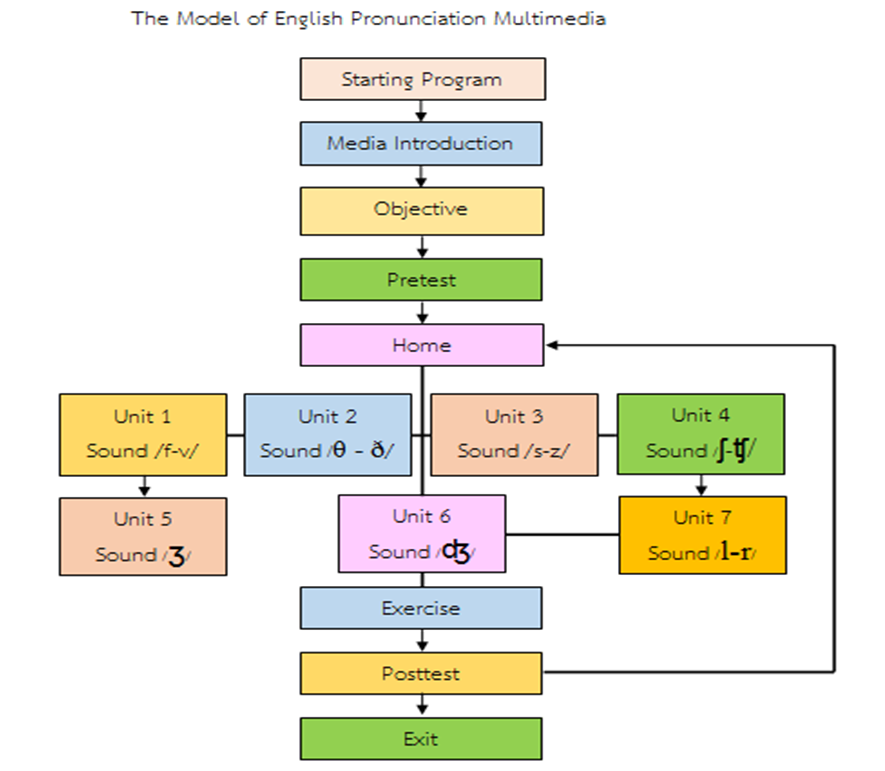IMPROVING THE ABILITIES IN ENGLISH PRONUNCIATION OF MATHAYOMSUKSA 1 (7th GRADE) STUDENTS BY USING MULTIMEDIA
Main Article Content
Abstract
The objectives of this research article were 1) to develop multimedia with English pronunciation for class grade 7 with 80/80 performance criterion, 2) to compare English pronunciation abilities of Mathayomsuksa 1 students before and after the learning using the English pronunciation multimedia, 3) to survey the students’ satisfaction with learning using the English pronunciation multimedia for Mathayomsuksa 1 students. The sample of this study consisted of 25 Mathayomsuksa 1 students in Ban Nongpan School, Na Dun District, Maha Sarakham Province selected by using the purposive sampling technique. The instruments for data collection in this research consisted of 7 learning plans, the English pronunciation multimedia for Mathayomsuksa 1 students, an achievement test and a satisfaction questionnaire. The statistics used for data analyses were mean, standard deviation and dependent sample t-test for testing hypothesis.
The results of the research were as follows: 1. the efficiency of the multimedia to improve English pronunciation skills for Mathayomsuksa 1 students, developed by the researcher, was 89.03/89.60, which was higher than the defined criterion. 2. The English pronunciation abilities of Mathayomsuksa 1 students was higher than before learning using the English pronunciation multimedia with at the 0.05 level of significance and corresponding with the hypothesis, and 3. The satisfaction of Mathayomsuksa 1 students with the learning using the English pronunciation multimedia for Mathayomsuksa 1 students, showed the averagesatisfaction score at high level, indicating that the students were highly satisfied.
Article Details

This work is licensed under a Creative Commons Attribution-NonCommercial-NoDerivatives 4.0 International License.
References
Banafa, F. (2004). The Impact of the Internet and Multimedia on Pronunciation and Oral Communication of Arab College Students Learning English in the United States. Doctoral Dissertation. New Mexico State University. The United Stated of America.
Binturki, T.A. (2008). Analysis of Pronunciation Errors of Saudi ESL Learners. Master of Arts Degree. Southern Illinois University Carondale.
Boonchom Srisa-ard. (2002). Principles of preliminary research. Bangkok : Suwiriyasan.
Burden, P.R. and Byrd, D.M. (1999). Methods for Effective Teaching. Boston : Allyn & Bacon.
Cairncross, S., and Mannion, M. (2001). Interactive Multimedia and Learning: Realizing the Benefits. Innovations in education and teaching international. 38(2). 156-164.
Chaipa, K. (2005). English Phonetics and Basic Physiology. Loei : Loie Rajabhat University.
Derwing, T.M., and Rossitier, M.J. (2002). ESL Learners’ Perceptions of Their Pronunciation Needs and Strategies. System. 30(2). 155-166.
Ellis, Rod. (1997). Second Language Acquisition. Oxford : Oxford University Press.
Fei Ping Por. (2011). Design and Development of Multimedia Pronunciation Learning Management System for Non-Native English Speakers. University Sains Malaysia, Penang, Malaysia. Procedia-Social and Behavioral Sciences. 64. 584-593.
Fries, Charles C. (1970). Teaching and Leaning English as a Foreign Language. Ann Arber : The University of Michigan Press.
Garrigues, S. (1999). Overcoming Pronunciation Problems of English Teachers in Asia. Retrieved 21 May 2020. From http://asianbridges.com/pac2/presentations/ garrigues.html
Gilakjani, P.H. (2011). A Study on the Situation of Pronunciation Instruction in ESL/EFL Classrooms Journal of Studies in Education. Journal of Studies in Education. 1. 73-83.
Hardison, Debra M. (2004). Generalization of Computer-Assisted Prosody Training: Quantitative and Qualitative Findings. Language Learning & Technology. 8(1). 34-52.
Hofstetter FT. (2001). Multimedia Literacy. 3rd ed. New York : McGrawHill/Irwin.
Junkerd, R. (2011).The Development of a Multimedia Lesson on Speaking English for Communications about Interesting Places in Pakchong District for Prathomsuksa 5 Students. Rajamangala University of Technology Isan. 4(1). 70-79.
Kurt, S. (2018). ADDIE Model: Instructional Design. Retrieved 7 September 2018. From ttps://educationaltechnology.net/the-addie-model-instructional-design/
Moolkam, S. (2006). Learning Management Plan, Focusing on Critical Thinking. 3rd ed. Bangkok : Parbpim Ltd.
Nipattamanon, J. (2018). Utilizing English Pop Songs with Karaoke Application Among Young Adults to Enhance Connected Speech Production. The New English Teacher. 12(2). 59-67.
Office of the Basic Education Commission. (2008). Basic Education Core Curriculum B.E. 2551 (A. D. 2008). Bangkok : Ministry of Education.University.
Phatthiyathane, S. (2016). Measuring the Results of the Study. Department of Education and Development. Faculty of Education : Mahasarakham University.
Pimwam, K. (2012). The Effect of Teaching English Pronunciation through Songs of Prathomsuksa 4 Students at Watrahatphatigaram School. Thesis Master’s degree. Srinakharinwirot University.
Rozinah, J. (2005). Multimedia Dalam Pendidikan. Kuala Lumpu : Utusan Publications & Distributors Sdn. Bhd.Taylor.
Ruksuttee, S. (2001). Techniques for Learning Management and Writing Lesson Plans by Taking the Students as the Most Important. Bangkok : Pattanasuksa Publishing.
Seema Hasan, E. (2009). Mass Communication-Principles & Concepts”, (1st Edition), Mass Communication in India. 4th ed. Jaico Books : Mumbai, 2009.


